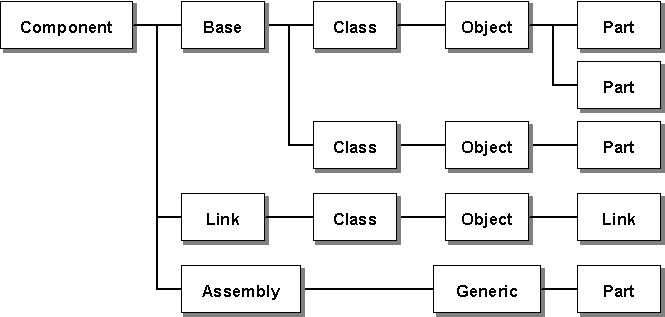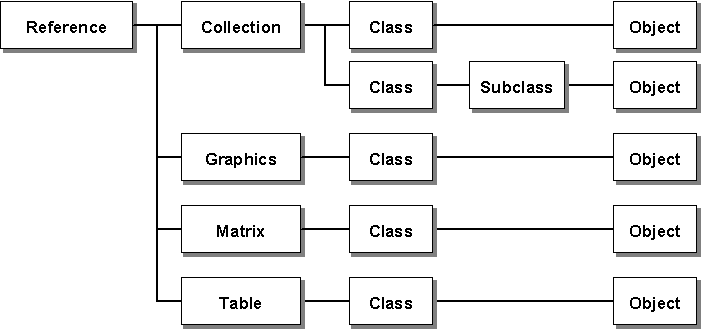
The classification of objects is essential in any object-oriented system. Classes are used to define the types of objects and the definitions of attributes in the objects. The SansGUI Object System allows hierarchical levels of classes and subclasses developed by the simulation developer. The definitions of classes, also known as class schemas, are simulator dependent. SansGUI provides simulation developers and users with a skeletal class framework for identification, organization, and handling of system entities. From the Model Construction section, we know that
Component objects are physical objects used to create parts and links.
Reference objects are informational objects referred to by other objects, parts, or links.
The Component class supports multiple-level classes defined by the simulation developer. From the simulation user's point of view, there are pre-defined component classes available to creating component objects, parts, and links. Component objects by themselves are not used for simulation execution in SansGUI. They simply supply the initial default values for parts and links.

The Base class contains atomic system entities which cannot be separated any further. This is a conceptual ramification in the simulator, not a real world constraint. The Link class is unique in a Project Model in the sense that there can be only one link class for creating all link objects and actual links in a simulator. The Assembly class is a SansGUI built in class that has no attribute. A Generic object is created out of the Assembly class for the simulation user to create parts with subassemblies. These parts are containers for sub-parts that may or may not have yet another level of sub-parts.
The Reference class contains various types of data objects defined by derived subclasses. Reference objects created from reference classes defined by the simulation developer cannot be used to derive further objects, such as parts or links from component objects. Their names are used as symbolic references to themselves from other objects. Unlike component objects, reference objects can be evaluated during simulation.

The Collection class and its derivatives are, simply, a collection of different attributes. The class attributes are defined by the simulation developers. The Graphics class is similar to the Collection class and, in addition, supports interactive 3-dimensional graphics displays for scientific and engineering visualization and data exploration. The Matrix class contains a single attribute with up to three dimensions -- rows, columns and sheets. The sizes of the matrices are specified interactively or programmatically by the simulation user or developer. The Table class and its derivatives have a series of attributes forming a table, with either row or column being enumerated and a possible 3rd dimension -- sheets. When the rows are enumerated, the attributes are aligned in columns and; therefore, the table is column-oriented. Similar rule applies to row-oriented tables, which have attributes aligned in rows and their columns being enumerated.
SansGUI Modeling and Simulation Environment Version 1.2
Copyright © 2000-2003 ProtoDesign, Inc. All rights reserved.